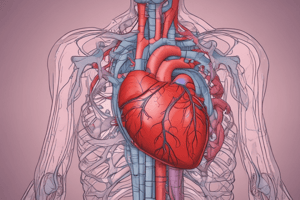Podcast
Questions and Answers
What is the consequence of elevated left ventricular pressure during diastole?
What is the consequence of elevated left ventricular pressure during diastole?
- Decreased pulmonary capillary hydrostatic pressure
- Transudation of fluid into the pulmonary interstitium (correct)
- Reduced ejection fraction
- Increased left atrial pressure
Which condition may result from impaired diastolic relaxation or mechanical obstruction?
Which condition may result from impaired diastolic relaxation or mechanical obstruction?
- Arrhythmogenic right ventricular cardiomyopathy
- Heart failure with preserved ejection fraction (correct)
- Dilated cardiomyopathy
- Systolic heart failure
Which of the following conditions leads to diastolic dysfunction due to reduced chamber compliance?
Which of the following conditions leads to diastolic dysfunction due to reduced chamber compliance?
- Myocardial ischemia (correct)
- Aortic regurgitation
- Coronary artery disease
- Ventricular septal defect
What happens when the right ventricle fails?
What happens when the right ventricle fails?
What is the most common cause of isolated right ventricular failure?
What is the most common cause of isolated right ventricular failure?
What primarily affects stroke volume in a healthy heart?
What primarily affects stroke volume in a healthy heart?
Which of the following conditions is associated with impaired myocardial contractility?
Which of the following conditions is associated with impaired myocardial contractility?
How does increased preload typically affect stroke volume according to the Frank-Starling mechanism?
How does increased preload typically affect stroke volume according to the Frank-Starling mechanism?
What does afterload refer to in the context of cardiac function?
What does afterload refer to in the context of cardiac function?
What is a consequence of impaired contractility in the heart?
What is a consequence of impaired contractility in the heart?
In which situation would you expect to see increased afterload?
In which situation would you expect to see increased afterload?
What is normally true of the cardiac output in a healthy individual?
What is normally true of the cardiac output in a healthy individual?
Which of the following is NOT a mechanism affecting stroke volume?
Which of the following is NOT a mechanism affecting stroke volume?
Flashcards
Cardiac output
Cardiac output
The amount of blood pumped by the heart per minute, adjusted to meet the body's metabolic needs.
Stroke volume
Stroke volume
The volume of blood ejected from the ventricle with each heartbeat.
Ventricular Preload
Ventricular Preload
The stretch on the heart muscle before contraction, influencing stroke volume.
Ventricular Afterload
Ventricular Afterload
Signup and view all the flashcards
Myocardial Contractility
Myocardial Contractility
Signup and view all the flashcards
Systolic Heart Failure
Systolic Heart Failure
Signup and view all the flashcards
Impaired Ventricular Filling
Impaired Ventricular Filling
Signup and view all the flashcards
Frank-Starling Mechanism
Frank-Starling Mechanism
Signup and view all the flashcards
Diastolic Dysfunction
Diastolic Dysfunction
Signup and view all the flashcards
Pulmonary Congestion
Pulmonary Congestion
Signup and view all the flashcards
Elevated Left Ventricular Pressure
Elevated Left Ventricular Pressure
Signup and view all the flashcards
Right Ventricular Afterload
Right Ventricular Afterload
Signup and view all the flashcards
Systemic Vein Congestion
Systemic Vein Congestion
Signup and view all the flashcards
Study Notes
Cardiac Function and Heart Failure
- Heart accepts blood at low pressure during diastole, then propels it at higher pressures in systole.
- Cardiac output matches metabolic needs via heart rate and stroke volume adjustments.
- Stroke volume depends on preload, afterload, and contractility.
- Preload (stretch on myocardial fibers) increases ventricular output within physiological limits.
- Afterload (ventricular wall stress during ejection) reflects resistance to emptying and determines end-systolic volume, independent of preload.
- Contractility refers to changes in contraction force, independent of preload/afterload, increased by actin-myosin cross-bridge cycling.
- Heart failure grouped by impaired contractility, increased afterload, or impaired filling.
- Systolic HF: reduced ventricle ejection due to impaired contractility or high afterload.
- Loss of contractility causes destruction of myocytes, abnormal function or fibrosis (e.g., dilated cardiomyopathy, volume overload, ischemia/infarction).
- Pressure overload impairs ejection, raising the end-systolic volume.
- Increased end-systolic volume plus normal pulmonary return elevates end-diastolic volume and pressure.
- Excessive afterload causes conditions like uncontrolled hypertension and aortic stenosis.
- While increased preload increases stroke volume (Frank-Starling), impaired contractility or afterload maintain elevated end-diastolic volume.
- Elevated left ventricular pressure during diastole transmits to left atrium, pulmonary veins, and capillaries, causing pulmonary congestion.
- Heart failure with preserved ejection fraction results from impaired ventricular filling (mechanical obstruction or impaired diastolic relaxation).
- Conditions like left ventricular hypertrophy, hypertrophic cardiomyopathy, restrictive cardiomyopathy, and myocardial ischemia cause reduced chamber compliance and diastolic dysfunction.
- Mitral stenosis and pericardial constriction obstruct filling, needing elevated diastolic pressures.
- Isolated right ventricular failure is less common, usually from increased right ventricular afterload (lung/pulmonary vessel disease).
- Most common cause of right ventricular failure is left-sided heart failure leading to elevated pulmonary vascular pressure and right ventricular afterload.
Studying That Suits You
Use AI to generate personalized quizzes and flashcards to suit your learning preferences.




